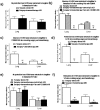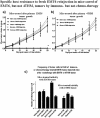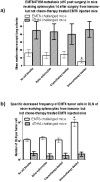Comparison of immunity in mice cured of primary/metastatic growth of EMT6 or 4THM breast cancer by chemotherapy or immunotherapy
- PMID: 25409195
- PMCID: PMC4237434
- DOI: 10.1371/journal.pone.0113597
Comparison of immunity in mice cured of primary/metastatic growth of EMT6 or 4THM breast cancer by chemotherapy or immunotherapy
Abstract
Purpose: We have compared cure from local/metastatic tumor growth in BALB/c mice receiving EMT6 or the poorly immunogenic, highly metastatic 4THM, breast cancer cells following manipulation of immunosuppressive CD200:CD200R interactions or conventional chemotherapy.
Methods: We reported previously that EMT6 tumors are cured in CD200R1KO mice following surgical resection and immunization with irradiated EMT6 cells and CpG oligodeoxynucleotide (CpG), while wild-type (WT) animals developed pulmonary and liver metastases within 30 days of surgery. We report growth and metastasis of both EMT6 and a highly metastatic 4THM tumor in WT mice receiving iv infusions of Fab anti-CD200R1 along with CpG/tumor cell immunization. Metastasis was followed both macroscopically (lung/liver nodules) and microscopically by cloning tumor cells at limiting dilution in vitro from draining lymph nodes (DLN) harvested at surgery. We compared these results with local/metastatic tumor growth in mice receiving 4 courses of combination treatment with anti-VEGF and paclitaxel.
Results: In WT mice receiving Fab anti-CD200R, no tumor cells are detectable following immunotherapy, and CD4+ cells produced increased TNFα/IL-2/IFNγ on stimulation with EMT6 in vitro. No long-term cure was seen following surgery/immunotherapy of 4THM, with both microscopic (tumors in DLN at limiting dilution) and macroscopic metastases present within 14 d of surgery. Chemotherapy attenuated growth/metastases in 4THM tumor-bearers and produced a decline in lung/liver metastases, with no detectable DLN metastases in EMT6 tumor-bearing mice-these latter mice nevertheless showed no significantly increased cytokine production after restimulation with EMT6 in vitro. EMT6 mice receiving immunotherapy were resistant to subsequent re-challenge with EMT6 tumor cells, but not those receiving curative chemotherapy. Anti-CD4 treatment caused tumor recurrence after immunotherapy, but produced no apparent effect in either EMT6 or 4THM tumor bearers after chemotherapy treatment.
Conclusion: Immunotherapy, but not chemotherapy, enhances CD4+ immunity and affords long-term control of breast cancer growth and resistance to new tumor foci.
Conflict of interest statement
Figures





Similar articles
-
A comparison of serum miRNAs influencing metastatic growth of EMT6 vs 4THM tumor cells in wild-type and CD200R1KO mice.Breast Cancer Res Treat. 2017 Apr;162(2):255-266. doi: 10.1007/s10549-017-4128-5. Epub 2017 Feb 3. Breast Cancer Res Treat. 2017. PMID: 28160157
-
Characterization of an in vitro model system to explore control of tumor invasion of EMT6 and 4THM breast tumors by CD200:CD200R interactions.Breast Cancer. 2018 Sep;25(5):547-559. doi: 10.1007/s12282-018-0851-y. Epub 2018 Mar 12. Breast Cancer. 2018. PMID: 29532324
-
Bidirectional effect of CD200 on breast cancer development and metastasis, with ultimate outcome determined by tumor aggressiveness and a cancer-induced inflammatory response.Oncogene. 2015 Jul;34(29):3860-70. doi: 10.1038/onc.2014.317. Epub 2014 Sep 29. Oncogene. 2015. PMID: 25263452
-
CD200-CD200R Pathway in the Regulation of Tumor Immune Microenvironment and Immunotherapy.Adv Exp Med Biol. 2020;1223:155-165. doi: 10.1007/978-3-030-35582-1_8. Adv Exp Med Biol. 2020. PMID: 32030689 Free PMC article. Review.
-
International guidelines for management of metastatic breast cancer: can metastatic breast cancer be cured?J Natl Cancer Inst. 2010 Apr 7;102(7):456-63. doi: 10.1093/jnci/djq029. Epub 2010 Mar 10. J Natl Cancer Inst. 2010. PMID: 20220104 Free PMC article. Review.
Cited by
-
Tumor-derived granulocyte colony-stimulating factor diminishes efficacy of breast tumor cell vaccines.Breast Cancer Res. 2018 Oct 22;20(1):126. doi: 10.1186/s13058-018-1054-3. Breast Cancer Res. 2018. PMID: 30348199 Free PMC article.
-
Advances in Immunotherapy and the TGF-β Resistance Pathway in Metastatic Bladder Cancer.Cancers (Basel). 2021 Nov 16;13(22):5724. doi: 10.3390/cancers13225724. Cancers (Basel). 2021. PMID: 34830879 Free PMC article. Review.
-
Oncolytic Reovirus and Immune Checkpoint Inhibition as a Novel Immunotherapeutic Strategy for Breast Cancer.Cancers (Basel). 2018 Jun 15;10(6):205. doi: 10.3390/cancers10060205. Cancers (Basel). 2018. PMID: 29914097 Free PMC article.
-
Shortwave-Infrared-Emitting Nanoprobes for CD8 Targeting and In Vivo Imaging of Cytotoxic T Cells in Breast Cancer.Adv Nanobiomed Res. 2024 Feb;4(2):2300092. doi: 10.1002/anbr.202300092. Epub 2023 Dec 5. Adv Nanobiomed Res. 2024. PMID: 39554690 Free PMC article.
-
CDK4/6 inhibitors synergize with radiotherapy to prime the tumor microenvironment and enhance the antitumor effect of anti-PD-L1 immunotherapy in triple-negative breast cancer.J Biomed Sci. 2025 Aug 20;32(1):79. doi: 10.1186/s12929-025-01173-3. J Biomed Sci. 2025. PMID: 40836337 Free PMC article.
References
Publication types
MeSH terms
Substances
LinkOut - more resources
Full Text Sources
Other Literature Sources
Medical
Research Materials

